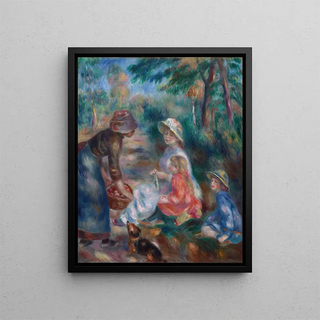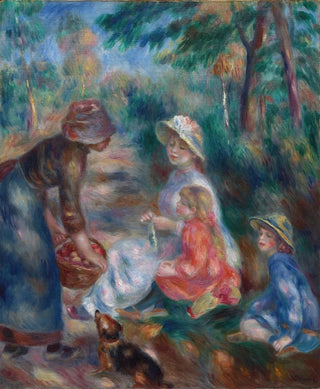Art print | The Apple Seller - Pierre-Auguste Renoir


View from behind

Frame (optional)
In the vibrant world of Impressionism, "The Apple Seller" by Pierre-Auguste Renoir stands out as an iconic artwork, capturing not only a moment of everyday life but also the very essence of Renoir's art. This painting, depicting a fruit merchant in a lively scene, invites the viewer to immerse themselves in a warm and colorful atmosphere. Through its fluid brushstrokes and vivid palette, Renoir manages to evoke a sense of joy and lightness, transforming a simple apple seller into a lively, almost tangible character. The piece, while rooted in daily life, transcends the mundane to offer a reflection on the beauty of life's small pleasures.
Style and uniqueness of the work
Renoir's style is characterized by a bold use of color and light, which gives his works an almost tactile quality. In "The Apple Seller," the warm hues of orange and red of the fruits contrast with the softer shades of the background, creating a captivating visual dynamic. The way Renoir plays with shadows and highlights brings the scene to life, making the apple seller both human and approachable. The facial details, though treated with a certain economy, are imbued with expressiveness that reveals a deep understanding of human nature. This painting is a celebration of life, where each element, from the seller's smile to the shine of the apples, is carefully orchestrated to convey an atmosphere of conviviality and joy.
The artist and his influence
Pierre-Auguste Renoir, a major figure of the Impressionist movement, left a lasting mark on his era with his unique vision of art. Born in 1841, he began his career painting scenes of everyday life before evolving toward more complex and luminous compositions. His influence extends far beyond his own work, inspiring many artists to explore color and light with the same passion. Renoir captured the spirit of his time, offering a new perspective on the beauty and simplicity of life. His innovative approach paved the way for generations of artists, who continue to

Matte finish

View from behind

Frame (optional)
In the vibrant world of Impressionism, "The Apple Seller" by Pierre-Auguste Renoir stands out as an iconic artwork, capturing not only a moment of everyday life but also the very essence of Renoir's art. This painting, depicting a fruit merchant in a lively scene, invites the viewer to immerse themselves in a warm and colorful atmosphere. Through its fluid brushstrokes and vivid palette, Renoir manages to evoke a sense of joy and lightness, transforming a simple apple seller into a lively, almost tangible character. The piece, while rooted in daily life, transcends the mundane to offer a reflection on the beauty of life's small pleasures.
Style and uniqueness of the work
Renoir's style is characterized by a bold use of color and light, which gives his works an almost tactile quality. In "The Apple Seller," the warm hues of orange and red of the fruits contrast with the softer shades of the background, creating a captivating visual dynamic. The way Renoir plays with shadows and highlights brings the scene to life, making the apple seller both human and approachable. The facial details, though treated with a certain economy, are imbued with expressiveness that reveals a deep understanding of human nature. This painting is a celebration of life, where each element, from the seller's smile to the shine of the apples, is carefully orchestrated to convey an atmosphere of conviviality and joy.
The artist and his influence
Pierre-Auguste Renoir, a major figure of the Impressionist movement, left a lasting mark on his era with his unique vision of art. Born in 1841, he began his career painting scenes of everyday life before evolving toward more complex and luminous compositions. His influence extends far beyond his own work, inspiring many artists to explore color and light with the same passion. Renoir captured the spirit of his time, offering a new perspective on the beauty and simplicity of life. His innovative approach paved the way for generations of artists, who continue to






